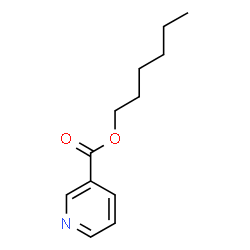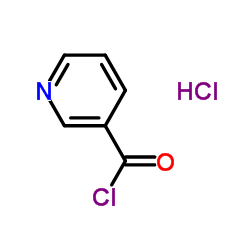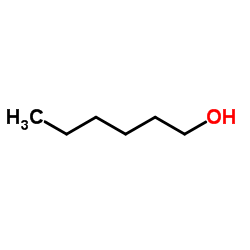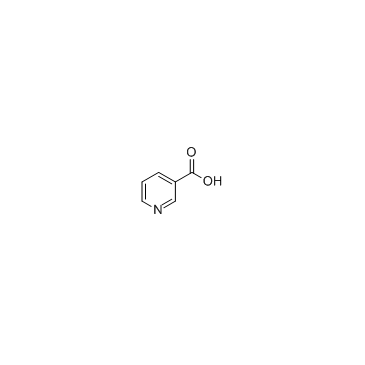Hexyl nicotinoate

Hexyl nicotinoate structure
|
Common Name | Hexyl nicotinoate | ||
|---|---|---|---|---|
| CAS Number | 23597-82-2 | Molecular Weight | 207.26900 | |
| Density | 1,02 g/cm3 | Boiling Point | 140°C | |
| Molecular Formula | C12H17NO2 | Melting Point | N/A | |
| MSDS | N/A | Flash Point | 140ºC | |
Use of Hexyl nicotinoateHexyl nicotinate, a nicotinic acid ester with vasodilatory effect. Hexyl nicotinate improves blood circulation, usually serves as an active ingredient in topical preparations, such as creams and lotions[1]. |
| Name | hexyl pyridine-3-carboxylate |
|---|---|
| Synonym | More Synonyms |
| Description | Hexyl nicotinate, a nicotinic acid ester with vasodilatory effect. Hexyl nicotinate improves blood circulation, usually serves as an active ingredient in topical preparations, such as creams and lotions[1]. |
|---|---|
| Related Catalog | |
| References |
| Density | 1,02 g/cm3 |
|---|---|
| Boiling Point | 140°C |
| Molecular Formula | C12H17NO2 |
| Molecular Weight | 207.26900 |
| Flash Point | 140ºC |
| Exact Mass | 207.12600 |
| PSA | 39.19000 |
| LogP | 2.81870 |
| Vapour Pressure | 0.000181mmHg at 25°C |
| Index of Refraction | 1.495 |
| InChIKey | RVYGVBZGSFLJKH-UHFFFAOYSA-N |
| SMILES | CCCCCCOC(=O)c1cccnc1 |
|
Section 1. Chemical Product and Company Identification Hexyl Nicotinate Common Name/ Trade Name Hexyl Nicotinate Section 4. First Aid Measures Check for and remove any contact lenses. In case of contact, immediately flush eyes with plenty of water for at least
Eye Contact 15 minutes. Get medical attention if irritation occurs. Wash with soap and water. Cover the irritated skin with an emollient. Get medical attention if irritation develops. Skin Contact Serious Skin ContactNot available. InhalationIf inhaled, remove to fresh air. If not breathing, give artificial respiration. If breathing is difficult, give oxygen. Get medical attention. Not available. Serious Inhalation Do NOT induce vomiting unless directed to do so by medical personnel. Never give anything by mouth to an Ingestion unconscious person. If large quantities of this material are swallowed, call a physician immediately. Loosen tight clothing such as a collar, tie, belt or waistband. Not available. Serious Ingestion Section 5. Fire and Explosion Data Flammability of the Product May be combustible at high temperature. Auto-Ignition Temperature Not available. CLOSED CUP: >109°C (228.2°F). Flash Points Not available. Flammable Limits These products are carbon oxides (CO, CO2), nitrogen oxides (NO, NO2...). Products of Combustion Fire Hazards in Presence of Slightly flammable to flammable in presence of open flames and sparks, of heat. Various Substances Risks of explosion of the product in presence of mechanical impact: Not available. Explosion Hazards in Risks of explosion of the product in presence of static discharge: Not available. Presence of Various Substances SMALL FIRE: Use DRY chemical powder. Fire Fighting Media LARGE FIRE: Use water spray, fog or foam. Do not use water jet. and Instructions Not available. Special Remarks on Fire Hazards Not available. Special Remarks on Explosion Hazards Section 6. Accidental Release Measures Absorb with an inert material and put the spilled material in an appropriate waste disposal. Small Spill Absorb with an inert material and put the spilled material in an appropriate waste disposal. Finish cleaning by Large Spill spreading water on the contaminated surface and allow to evacuate through the sanitary system. Hexyl Nicotinate Section 7. Handling and Storage Keep away from heat. Keep away from sources of ignition. Ground all equipment containing material. Do not Precautions breathe gas/fumes/ vapor/spray. Keep away from incompatibles such as oxidizing agents. Keep container tightly closed. Keep container in a cool, well-ventilated area. Storage Section 8. Exposure Controls/Personal Protection Provide exhaust ventilation or other engineering controls to keep the airborne concentrations of vapors below their Engineering Controls respective threshold limit value. Ensure that eyewash stations and safety showers are proximal to the work-station location. Personal ProtectionSafety glasses. Lab coat. Gloves (impervious). Respiratory protection is not necessary for normal handling. Good room ventilation or use of local exhaust (fume hood) is sufficient. Use a vapor respirator under conditions where exposure to the substance is apparent (e.g. generation of high concentrations of mist or vapor, inadequate ventilation, development of respiratory tract irritation), and engineering controls are not feasible. Be sure to use an approved/certified respirator or equivalent. Personal Protection in Case Splash goggles. Full suit. Boots. Gloves. Suggested protective clothing might not be sufficient; consult a specialist of a Large SpillBEFORE handling this product. Exposure LimitsNot available. Section 9. Physical and Chemical Properties Liquid.Not available. Physical state andO dor appearance Not available. Taste 207.3 g/mole Molecular Weight Not available. Color Not available. pH (1% soln/water) 147°C (296.6°F) Boiling Point Not available. Melting Point Not available. Critical Temperature 1.02 (Water = 1) Specific Gravity Not available. Vapor Pressure Not available. Vapor Density Not available. Volatility Not available. Odor Threshold Not available. Water/Oil Dist. Coeff. Not available. Ionicity (in Water) Not available. Dispersion Properties Not available. Solubility Section 10. Stability and Reactivity Data The product is stable. Stability Not available. Instability Temperature Conditions of Instability Excess heat, incompatible materials Incompatibility with various Reactive with oxidizing agents. substances Hexyl Nicotinate Not available. Corrosivity Not available. Special Remarks on Reactivity Not available. Special Remarks on Corrosivity Will not occur. Polymerization Section 11. Toxicological Information Absorbed through skin. Eye contact. Routes of Entry Toxicity to AnimalsLD50: Not available. LC50: Not available. Chronic Effects on Humans Not available. Slightly hazardous in case of skin contact (irritant), of ingestion, of inhalation. Other Toxic Effects on Humans Special Remarks onNot available. Toxicity to Animals Special Remarks onNot available. Chronic Effects on Humans Special Remarks on otherAcute Potential Health Effects: Skin: May cause skin irritation. Toxic Effects on Humans Eyes: May cause eye irritation. Inhalation: Inhalation of mist or vapor may cause respiratory tract irritation. Ingestion: Expected to be a low hazard. Section 12. Ecological Information Not available. Ecotoxicity Not available. BOD5 and COD Products of Biodegradation Possibly hazardous short term degradation products are not likely. However, long term degradation products may arise. The product itself and its products of degradation are not toxic. Toxicity of the Products of Biodegradation Not available. Special Remarks on the Products of Biodegradation Section 13. Disposal Considerations Waste must be disposed of in accordance with federal, state and local environmental control Waste Disposal regulations. Section 14. Transport Information Not a DOT controlled material (United States). DO T Cl assi fi cati on Not applicable. Identification Not applicable. Special Provisions for Transport Hexyl Nicotinate DO T (Pi ctograms) Section 15. Other Regulatory Information and Pictograms TSCA 8(b) inventory: Hexyl Nicotinate Federal and State Regulations California prop. 65: This product contains the following ingredients for which the State of California has found to California cause cancer which would require a warning under the statute: No products were found. Proposition 65 Warnings California prop. 65: This product contains the following ingredients for which the State of California has found to cause birth defects which would require a warning under the statute: No products were found. Other RegulationsEINECS: This product is on the European Inventory of Existing Commercial Chemical Substances (EINECS No. 245-767-4). Canada: Listed on Canadian Domestic Substance List (DSL). China: Not listed on National Inventory. Japan: Not listed on National Inventory (ENCS). Korea: Not listed on National Inventory (KECI). Philippines: Not listed on National Inventory (PICCS). Australia: Not listed on AICS. WHMIS (Canada) Not controlled under WHMIS (Canada). Other Classifications This product is not classified according Not applicable. DSCL (EEC) to the EU regulations. Health Hazard HMIS (U.S.A.)1 National Fire Protection 1 Flammability 1 Association (U.S.A.) Fire Hazard 1 0 Reactivity Health Reactivity0 Specific hazard Personal Protection B WHMIS (Canada) (Pictograms) DSCL (Europe) (Pictograms) TDG(Canada) (Pictograms) ADR (Europe) (Pictograms) Protective Equipment Gloves (impervious). Hexyl Nicotinate Lab coat. Not applicable. SECTION 16 - ADDITIONAL INFORMATION N/A |
| Hazard Codes | Xi |
|---|---|
| Risk Phrases | R36/37/38 |
| Safety Phrases | S26-S36/37/39 |
| HS Code | 2933399090 |
|
~% 
Hexyl nicotinoate CAS#:23597-82-2 |
| Literature: Journal of the American Chemical Society, , vol. 68, p. 187,189 |
|
~% 
Hexyl nicotinoate CAS#:23597-82-2 |
| Literature: Journal of the American Chemical Society, , vol. 67, p. 1135,1136 |
|
~% 
Hexyl nicotinoate CAS#:23597-82-2 |
| Literature: DE946541 , ; |
|
~% 
Hexyl nicotinoate CAS#:23597-82-2 |
| Literature: US2861077 , ; |
| Precursor 4 | |
|---|---|
| DownStream 0 | |
| HS Code | 2933399090 |
|---|---|
| Summary | 2933399090. other compounds containing an unfused pyridine ring (whether or not hydrogenated) in the structure. VAT:17.0%. Tax rebate rate:13.0%. . MFN tariff:6.5%. General tariff:20.0% |
| N-hexyl nicotinoate |
| Auxiliary substrate,1a |
| Nicotinsaeure-hexylester |
| Nicotinic Acid Hexyl Ester |
| Hexyl nicotinate |
| n-Hexyl nicotinate |
| Hexyl nicotinoate |
| 3-Pyridinecarboxylic acid,hexyl ester |
| EINECS 245-767-4 |
| Nicotinic acid,hexyl ester |
| 3-Hexyloxycarbonylpyridine |
| Nicotherm |
| MFCD00023587 |





